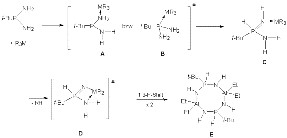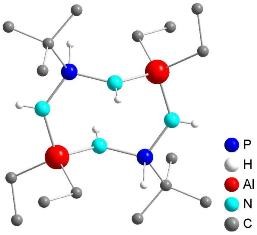Reactions of alkyl-bis(amino)phosphines
Reactions of alkyl-bis(amino)phosphines
t-BuP(NH2)2 reacts with the THF-BH3 phosphine-borane adduct t-Bu(NH2)2P-BH3,whereas the reaction with Me3N-AlH3 occurs with reduction of the bisaminophosphine (P-N- bond cleavage) and formation of t-BuPH2 [1].

Figure 1: Reaction of t-BuP(NH2)2 with THF-BH3
The different reactivity of t-BuP(NH2)2 compared to the base-stabilized MH3 compounds can be explained by using the HSAB concept. Thus the "soft" borane is complexed at the "soft" PIII-center under displacement of the weak ligand THF (ligand exchange). Any further elimination of hydrogen does not take place due to the relatively stable B-H bond. In the reaction with the relatively "hard" alane Me3N-AlH3 a reductive cleavage of the P-N bonds takes place to form t-BuPH2 and as yet unidentified Al-N compounds. The reason for this reaction behavior is thermodynamically favored by the Al-N bond formation.
On the other hand t-BuP(NH2)2 reacts with trialkyl compounds MR3 (M = Al, Ga, In; R = Me, t-Bu) or Et2AlH with formation of molecular metallonitridophosphinates of the type [t-Bu(H)P(NH)2MR2]2 [2]. The reactions occurs by migration of a proton from the N- to the P-center (NH-PH-tautomerism) and formation of the iminophosphorane adduct B, which was detected clearly in reactions with t-Bu3M as reaction intermediate by temperature depending 31P NMR spectroscopy. After elimination of an equivalent of alkane or hydrogen, the metallonitridophosphinates were isolated. The occurrence of a possible intermediate C, which is likely to theoretical calculations, could not be verified experimentally.

Figure 2: Reaction course of t-BuP(NH2)2 with MR3

Figure 3: Molecular structure of [t-Bu(H)P(NH)2MR2]2
t-BuP(NH2)2 reacts with Cp*TiMe3 at -70 °C initially under formation of [t-Bu(H)P(NH)NH2─Ti(Cp*)Me3]. Raising the temperatures resulted in a gas evolution and formation of various iminophosphoranes, from which [t-Bu(H)P(m-NH)2Ti(Cp*)Me2] was unambiguously characterized [3].
References
[1] T. Bauer, S. Chatterjee, S. Schulz, M. Nieger, I. Krossing, Z. Anorg. Allg. Chem. 2005, 631, 2900.
[2] (a) T. Bauer, S. Schulz, M. Nieger, I. Krossing, J. Chem. Soc. Chem. Commun. 2002, 1422. (b) T. Bauer, S. Schulz, M. Nieger, I. Krossing, Chem. Eur. J. 2004, 10, 1729.
[3] T. Bauer, S. Chatterjee, S. Schulz, M. Nieger, I. Krossing, Z. Anorg. Allg. Chem. 2005, 631, 2900.
